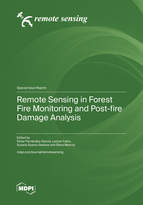Remote Sensing in Forest Fire Monitoring and Post-fire Damage Analysis
A special issue of Remote Sensing (ISSN 2072-4292). This special issue belongs to the section "Forest Remote Sensing".
Deadline for manuscript submissions: closed (31 October 2022) | Viewed by 45008
Special Issue Editors
Interests: remote sensing; soil science; vegetation science; fire ecology
Special Issues, Collections and Topics in MDPI journals
Interests: wildfire; resilience; post-fire regeneration
Special Issues, Collections and Topics in MDPI journals
Interests: biogeography; bird conservation; ecosystem services; fire-prone ecosystems; fire regime; heathlands; land use change; landscape ecology; mountain systems; perturbations; remote sensing; species distribution models; vegetation regeneration; wildland fires
Special Issues, Collections and Topics in MDPI journals
Interests: atmospheric pollution; effects of perturbations on soil and vegetation nutrients; forestry; soil burn severity; soil quality
Special Issues, Collections and Topics in MDPI journals
Special Issue Information
Dear Colleagues,
Forest fires are one of the most important disturbances across the world, which have produced negative impacts mainly in provisioning and regulating ecosystems services. Furthermore, during the last decade, the magnitude and extension of these fires have grown, making account management more difficult. In this context, remote sensing is a valuable tool to deal with the environmental challenges of fires and to drive solutions. Because of its versatility, the wealth of information it provides, and its rapid advances in technology, techniques, and platforms, remote sensing is an essential tool for forest management, monitoring, damage analysis, and result reporting with the aim to facilitate post-fire management.
This Special Issue invites studies covering new remote sensing technologies, sensors, data collections, and processing methodologies that can be successfully applied in post-fire damage mapping, ecosystems service recovery, and post-fire decision making after large forest fires. We welcome submissions that cover but are not limited to:
- Predictive mapping of post-fire biodiversity patterns in forests using species distribution models and remote sensing data;
- 3D mapping by photogrammetry, LiDAR, and SAR in post-fire studies;
- Using unmanned aerial vehicles (UAV) in post-fire studies;
- Remote sensing methods to quantify biophysical parameters of vegetation;
- Spectral unmixing models applied to the study of post-fire recovery of vegetation;
- Hyperspectral imagery applied to the study of soil burn severity and the post-fire recovery of soils;
- Analysis of fire impacts in the wildland-urban interface (WUI);
- Estimation of carbon losses in soil and vegetation caused by fires;
- Methods to estimate forest canopy status and vegetation recovery after fire;
- Analysis of post-fire erosion, changes in water sediment loads, and water quality using remote sensing methods.
Dr. Víctor Fernández-García
Dr. Leonor Calvo
Dr. Susana Suarez-Seoane
Dr. Elena Marcos
Guest Editors
Manuscript Submission Information
Manuscripts should be submitted online at www.mdpi.com by registering and logging in to this website. Once you are registered, click here to go to the submission form. Manuscripts can be submitted until the deadline. All submissions that pass pre-check are peer-reviewed. Accepted papers will be published continuously in the journal (as soon as accepted) and will be listed together on the special issue website. Research articles, review articles as well as short communications are invited. For planned papers, a title and short abstract (about 100 words) can be sent to the Editorial Office for announcement on this website.
Submitted manuscripts should not have been published previously, nor be under consideration for publication elsewhere (except conference proceedings papers). All manuscripts are thoroughly refereed through a single-blind peer-review process. A guide for authors and other relevant information for submission of manuscripts is available on the Instructions for Authors page. Remote Sensing is an international peer-reviewed open access semimonthly journal published by MDPI.
Please visit the Instructions for Authors page before submitting a manuscript. The Article Processing Charge (APC) for publication in this open access journal is 2700 CHF (Swiss Francs). Submitted papers should be well formatted and use good English. Authors may use MDPI's English editing service prior to publication or during author revisions.








